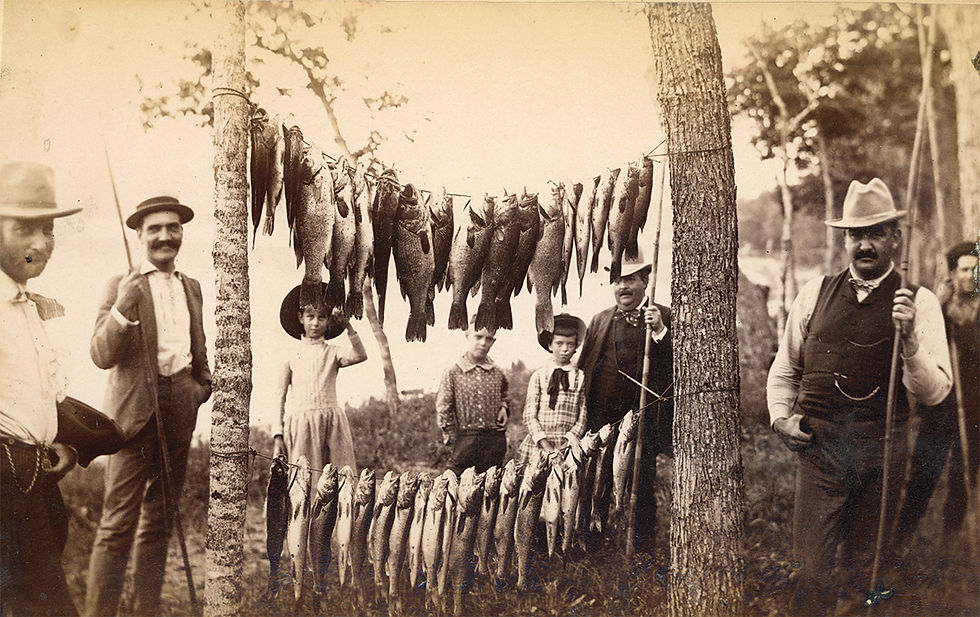‘Cereus business’ in Long Prairie
- Sr Perspective

- Jul 31, 2013
- 4 min read
Tony Borgheiinck, the proprietor of Custer Floral and Greenhouse in Long Prairie had to stay up late to see the flowers of his night-blooming cereus for five nights at the end of June. He has had the tree-like cactus, which only blooms at night, for about 20 years. It is now 12 feet tall with three branches.

Blooms at different times over several evenings on Borgheiinck’s night-blooming cereus. Photo by Tony Borgheiinck
“Ours has bloomed once before about two years ago,” said Borgheiinck,“this year it has produced 19 flowers over a five-night period.”
Up to six flowers opened each night. The buds swelled and opened after dark at about 10:30-11 p.m. revealing 6-inch diameter, white flowers on the cactus. By 9 a.m. the flowers started to fade, and by 10:30, they were totally exhausted. “The pictures don’t do justice to seeing and watching it happen,”said Borgheiinck.
His wife has always been a plant lover and can’t keep her hands out of the dirt, so he had appeal to him anyway. After they got married and had a 10-day honeymoon, they bought their greenhouse and floral business in 1970 from someone who was retiring and have been at it ever since.
“Before owning the greenhouse, I was a plant buyer,” Borgheiinck said. Not quite the same line of work, he actually bought supplies for a steel plant.
With running a floral shop and greenhouse to keep him busy, Borgheiinck doesn’t give the cereus any special care other than growing it in the sand of the greenhouse. He said they should bloom yearly in the Southwestern U.S.
Before the 1920s almost all tall columnar cacti would have been lumped together and known as cereus. This makes it hard to sort them out and track down where the plants originated from. Many cacti have been reclassified but dozens are still known as cereus. With further study, more will likely be renamed.
Daiv Freeman, also from Long Prairie, runs a website called cactiguide.com. Freeman has a large collection of cacti, and when asked about this tall plant, he said it is known as cereus peruvianus. The name misguides growers, as the plants are more likely to have originated from Brazil, Uruguay, and Argentina than Peru.
“The tall cereus is literally a tree and grows quite large,” Freeman said.

Roots of the large cactus shown growing into the greenhouse soil.
Not all cacti known as cereus are tall like the one in Long Prairie. Some are grown in hanging baskets and climb trees in milder climates,where they can grow outside year-round. Some night-blooming cereus cacti are also known by fancy names, like princess of the night, Honolulu queen, moonflower and queen of the night.
A jumble of confusing names and mysterious origins makes it hard to pin down exactly which night-blooming cereus you see. But they all bloom at night, often not more than a few nights a year and have large, stunning pale flowers, usually with a pleasing odor that can fill a whole room.
Where the plants are more well known, friends hastily call together evening bloom parties to celebrate the flowers.
You may even remember an episode of Dennis the Menace where Mr. Wilson has a night-blooming cereus that he wants to photograph to publicize his local garden club. He falls asleep before it opens.
Because of their size, a night-blooming cereus like the one Borgheiinck has is not common in homes. He knows another person, Rob Weinhold in Little Sauk, who has a night-blooming cereus in a hobby greenhouse. He said Weinhold’s cereus also blooms rarely.
“To get them to bloom every year, you’d really need outdoor conditions like Southern California,” said Freeman who also grows one.
“Bats might be pollinators or some other night animals, but the day workers are out of luck,” Borgheiinck said when asked about the natural pollinators.
Freeman has seen moths pollinate his plant at night.
When pollinated, some varieties of cereus produce edible red fruits the size of a large chicken egg or tennis ball. In tropical areas you can even find one of these with what look like green scales, called dragonfruit, for sale at markets next to bananas.
“The rind is very sour, and the pulp is very mild. It has seeds that are about identical to poppy seeds in texture. Usually best when made into something – like blended into some sort of dessert,”said Freeman.
Eight days after flowering, the buds were falling off of Borgheiinck’s plant. He has not had any fruit grow on it. He is more interested in the beautiful, large flowers than he is in getting the fruit.
Cereus cacti are much more common in southern states where they can be grown outside as large landscape plants 20 feet tall.
“They are a bit less common here, but I think that a cutting from someone is still the best way to get them,” said Freeman.
Even in a northern state like Minnesota people have them around. They can be grown from seed if you have the time. Either way it could take 20 years to get a large plant and your own flowers like Borgheiinck’s that last for only one night.




Comments